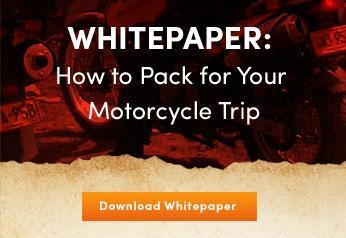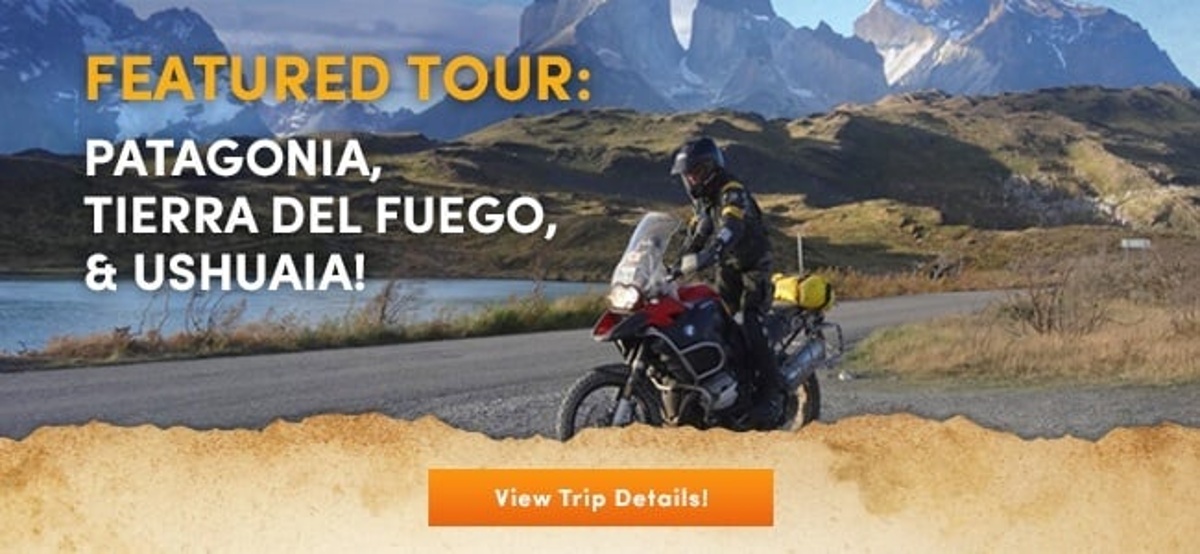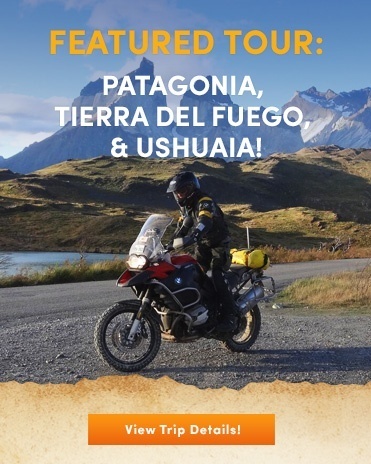
How will you pack for your upcoming motorcycle adventure?
Whether you’re about to ride from Machu Picchu to Ushuaia, through the Alps in Europe, or just across your own country, getting your adventure motorcycle gear ready for such a journey sure can be a challenge.
After thousands of miles on the road, in the dirt, and around the campfire, we at RIDE Adventures offer the following tips and suggestions to make sure you pack both efficiently, and with reason behind every item you bring:
Water Source
A motorcycle rider's best friend might be their hydration-pack, or basically a backpack with a water source built-in.
While you're riding, it´s just not possible to constantly keep opening a bottle to drink from, so this convenient water source hangs a hose over your shoulder for easy sipping while riding.
Make sure to buy one large enough not only to fill the water-bladder inside, but also to keep your passport, spare money, valuables and such safe and accessible at all times.
PURCHASING TIPS: 1) While shopping for this, remember that much of that useable storage space will disappear when you put the 2 or 3 liters of water in the bladder.
2) Don't “go cheap” on this purchase, or you'll be sure to have either torn seams or a leak in the water bladder in no time. In our opinion, “Camelbak” (www.camelbak.com) is leading the market and is even used by military forces around the world.
3) Only put pure water & ice in the bladder, no sweet drinks, sodas, etc. Those sugars found in many sport drinks might taste great, but they'll cause bacteria to grow in the hydration unit and you'll have your own human bladder infection in a day or two.
A few companies are making tablet-form powders meant specifically for these hydration units that add a better-than-plain-water flavor to your drink and add electrolytes without the sugars and bacteria. See www.nuun.com for an example.
Cold Weather/Rain Gear
In many famous riding areas around the world, the weather can change rapidly. Think you have the right waterproof riding gear already?
Just “thinking” you've got the right gear is not enough.
If the rain protection you've chosen is not personally proven by yourself while riding a motorcycle in significant rain for more than a couple of hours, DON'T TRUST IT!
Rain will not only permeate insufficient materials, but it will creep over collars, inside of sleeves, and from beneath waistlines. Once this leaking starts, every inch of your body will be soaked in a matter of minutes, and mixed with a cold wind: You'll be miserably uncomfortable in no time.
PURCHASING TIP: It's a tough fact that “you get what you pay for” in many cases, and such is typically true with rain gear.
Products made with GORE-TEX are generally considered some of the best, in that they allow your body to breath and release perspiration while shielding you from the elements.
A pure-rubber or plastic suit that doesn't breath can trap perspiration, allowing moisture to cling to your skin, and you’ll end up feeling just as cold as if rain water had made its way through to you.
There are many manufacturers out there offering quality products, but one recommendation we can make is found under the “Product Test” portion of our blog.
You’ll see we’ve reviewed riding gear by Klim USA (www.klimusa.com) with excellent results.
EXTRAS: With so much of our natural body heat escaping through our neck and head, the addition of a balaclava is an excellent idea.
Typically used in mountaineering and winter sports situations, finding one that fits under your helmet will make an enormous difference in keeping you warm.
At the very least, some kind of a neck-warmer will make a difference as well. Also, it’s a good idea to have a 2nd pair of riding gloves available.
As they get soaked in rainy climates, they probably won’t dry out overnight, so having a 2nd pair is helpful.
Clothing
Synthetic or Wool: “Good”
Cotton: “Bad”
It's as simple as that. You can greatly reduce the amount of space you'll need for clothes by reducing the number of shirts, socks, underwear, and interior layers by replacing everything made from cotton with a synthetic or wool item instead.
Quite easy to find these days are synthetic/micro-fiber shirts, underwear, and interior layers that advertise moisture-wicking properties. They'll keep you dry, comfortable, relatively odor-free, and most of the micro-fiber items can be washed in the shower or sink in the evening, and be dry enough to wear the following morning.
Plus, if you didn't remember to wash your underwear the night before, don't worry. Going an extra 2, or even 3 days in the same pair of micro-fiber underwear might sound disgusting, but it honestly isn't that bad!
You just need to be good at keeping secrets….ha, ha. (See websites like www.smartwool.com or www.underarmour.com for great products that we highly recommend.)
Want a downloadable version of this guide? Click below!
Padding/Protection
Many motorcycle apparel manufacturers are making their jackets and pants with removable padding already built in.
Depending on the manufacturer, those foam pads may or may not really help you much in the event of a crash, but in nearly every case, their coverage for you will not be as effective as a separate body armor system.
OUR RECOMMENDATION: A body armor jacket and kneepads like Alpinestar’s “Bionic” products (www.alpinestars.com) or Klim USA’s Tek/Tactical lineup (www.klimusa.com) provide the best protection, and in turn offer you a higher level of confidence while riding.
(Confidence being KEY to riding safely!)
Just by holding these products, you’ll agree the level of protection is superior to the padding included in typical jackets and pants.
HOW ABOUT COMFORT? Okay, you might lose a little bit of comfort, but most people would trade a little riding discomfort any day over the discomfort of a broken kneecap or elbow.
On the flip-side, in those hot weather situations when you so dearly want to remove your jacket but still want to keep your padding on for protection? Now you can take your jacket off for some relief from the pounding heat, but still have body armor on for safety.
It's perfect!
(Just be ready for almost everyone to start calling you “The Terminator” or “Robo Cop,” because that’s what you’ll look like wearing just the body armor. It's amazing how even in tiny villages in Mexico, Central America, or South America, somehow EVERYONE knows those two movies.)
Luggage bags
No, you are not allowed to borrow your wife's floral pattern matched luggage to strap across the back of your motorcycle!
Instead find a rugged, waterproof, and durable bag to store your clothes, tent, sleeping bag, and such in as well.
Make the investment, it'll be well worth it. Generally speaking, 90 liters of space or less should be plenty of space to pack all your clothing, tent, sleeping bag, etc.
Always buy the larger of the two you are thinking about, as the excess space can be cinched down without a problem. (See brands like www.ortlieb.com for their “Rack Pack,” www.outdoorresearch.com for their “Lateral Dry Bags” or other brands at major sporting goods and camping equipment stores.) These types of bags are also extremely easy to keep clean.
After a long, dirty day strapped to the motorcycle….just put the watertight bag on the floor of the shower with you and it’ll look like new again in no time.
Clamping/Winching Straps
Caution: Are your bags really secured, or could they slip off while riding? Admittedly, it happened to me once in high-winds in the Andes Mountains.
Cruising along at about 70mph, my bags slipped loose and fell down the back of the motorcycle, getting wrapped up in the rear wheel and “locking” it in place.
I was able to keep the bike upright and avoid crashing, but the outcome could have been much, much worse of course.
Aside from my luggage bags and some clothes being shredded, the 120-yard long skid burned an irreparable hole in the rear tire.
Don’t let this happen to you… think “overkill” when selecting the durability of your straps, and secure your luggage with a vengeance!
Sidecases/Topcases
Another topic that’s unique to each motorcycle, we won’t get too specific here. Just keep in mind a couple of key points if you have not yet chosen which cases to adorn your motorcycle with:
a) Certainly, you want a type that is locked to the motorcycle, and locked from opening.
b) Have a backup plan in mind should you have a crash and the original locks or mountain system are no longer supporting the case - see “Tie down straps” below.
c) Generally speaking, topcases do not hold up to the jarring and bouncing if you’ll be spending much time on tough terrain just because of their position on the motorcycle. Plus, with a topcase, it’s unlikely you’ll have much space remaining for strapping your luggage bag across the back, and...
d) As described below, you’ll want to make sure to store spare fuels/oils completely separate from any foods or textiles you’re bringing. Choose one side for your tools, fuels, and oils, and dedicate the other side to your foods and such.
Camping & Cooking
Another section of advice could be written about forever, but again, the basic thoughts are: don’t go cheap, and don’t wait until you’re on your trip to test it for the first time!
TENTS - How much space you’ll need you can probably figure out. Just keep in mind that at night, you’ll probably want your riding gear and bags inside the tent with you, and then a 1-man tent will not be enough space.
We personally have used the REI Half Dome tent (www.rei.com/product/728308) an impressive number of times in the past 2 years, often in extremely high winds and rain, and have nothing but good things to say about it.
Light, compact, very tough, and fairly priced, it has been a truly great purchase. There are other tents specifically built to handle the highest of winds, but the Half Dome really might be all you need. It’s a great value.
SLEEPING BAGS - The lightweight & compact, down-filled sleeping bag might seem like a great idea, but if you get it wet: Forget it.
Experienced users will tell you it takes a long, long time to dry out a down-filled bag, and will certainly take longer if you have to pack it up and ride everyday instead of having it out in the fresh air to dry.
Synthetic bags are cheaper, dry more quickly, and only require a little more space to carry.
What temperature range should you choose? Your personal travel plans will have to answer that, but instead of buying a “sleeping bag liner” that are often sold to compliment your sleeping bag and get another 5-10 degrees Fahrenheit of warmth, I recommend just using wool or synthetic long underwear.
That base-layer underwear can serve you while riding during the day if it’s cold, and do the same thing as a bag liner at night.
Money, space, weight, and world resources saved!
BURNERS/STOVES – Cooking around the campfire with your friends after a great day’s ride: It doesn’t get much better than this!
Maybe the campfire itself will be your heat source, but it might be good to have a simple fuel-powered burner along with you as well.
Which one?
“Multi-Fuel” is the key term to look for those stoves that run on white gas, kerosene, or unleaded auto/motorcycle fuel.
Why buy a Multi-Fuel stove?
Think about it: At least one of those fuels is available almost everywhere in the world, and what happens when you run out of gas on your motorcycle just 5 miles before the gas station?
You’ll have anywhere from ½, to 1 and ½ liters of extra gas that you need already with you from your cooking equipment. Beautiful!
(That 1 liter or so has already saved us a few times from having to spend 2-3 hours walking back and forth in my heavy motorcycle boots.)
OUR RECOMMENDATION: The MSR WhisperLite International Stove has been great, www.msrcorp.com. Very fairly priced, extremely light and durable, we have nothing but good things to say about it.
(NOTE: Always store your fuel bottle separate from clothes, food, or anything that you don’t want to smell & taste like gas forever. Just a one-day ride with your fuel in the same compartment will be enough to have any textile permanently saturated with the scent of fuel. For example, if you use a dry sack to carry breakfast cereal, a fuel-stained dry sack will FOREVER be transferring that fuel taste into your breakfast!)
POTS/PANS – Stainless Steel, Titanium, or Aluminum? Aluminum cooks most efficiently, but is the least durable.
Titanium is the lightest, but most expensive. Stainless is the heaviest, but most durable. Yada, yada, yada……you can spend days reading reviews and opinions online regarding which is best.
Our personal experiences are with stainless steel, and we are very pleased with the Primus Stainless Steel Gourmet II set (www.primuscamping.com.)
Store your stove and a few more things inside the pots using the pan as a lid, and it really packs down into a convenient and durable resource.
ACCESSORIES – Between MSR, Primus, Outdoor Research, REI, and the other big-name manufacturers, you’ll find everything you need in terms of knives, cutting boards, spatulas, lighters, and cleaning utensils.
Another reason to practice your cooking routine before you leave is that it’ll help you figure which items you might be forgetting.
HEAD LAMP – What good is all of this if you forgot to buy a headlamp so you can see what you’re doing in the dark?
Easy to use, cheap, battery-operated, and essential to camping life is your forehead-mounted headlamp (and so much more convenient than holding a flashlight!) See a popular brand like Petzl for a variety of options at www.petzl.com.
OUR RECOMMENDATION: Get one that operates on AAA or larger batteries. The smaller coin-shaped battery headlamps never seem to last as long or be bright enough, and those types of batteries are not as easy to find as AAA, or AA.
Locking your Motorcycle & Gear
Always consider how your luggage or tank bag is strapped & secured to your motorcycle.
For example, do you plan to do some hiking & site-seeing during your day or crossing borders into other countries? Get ready to spend at least a couple hours in between each country, in many cases well out of visual range of your motorcycle.
Unless you're with a travel partner that watches your belongings while taking turns doing border paperwork, a luggage bag simply strapped to your bike can easily be stolen by the time you return.
Either plan on carrying tank bags, luggage bags, and your helmet with you, or find some secure way to lock these items to the motorcycle.
(Think about the locking system you’re buying. A simple 1/8 inch cable can be cut very quickly with a standard pair of side-cutters that fits in any thieve's pocket.)
Many different philosophies exist about disc-locks to keep your motorcycle from being stolen, or cables to secure the bike to another object.
If traveling with other riders, a high-quality U-Lock that locks your two bikes together closely can make it very difficult for thieves to even reach the lock.
(And next to impossible to load two motorcycles into a truck at the same time.)
We like a disc lock when traveling alone. With an alarm built-in, that’s a pretty good deterrent.
Tools
The list of tools to bring will of course be different for every motorcycle.
If you haven't been working on your motorcycle enough to figure which tools apply to your situation, at least go online and search many of the motorcycle forums to read suggestions from other owners of the same motorcycle (www.ktm950.info, www.klr650.net, or www.r1200gs.info for example.)
Again trying to limit the amount of items you bring with, doing your best to find “multi-purpose” tools will obviously serve a purpose.
One great item to have is a Leatherman product found on www.leatherman.com.
“Trick Fix-Its and Riggings”
These items don't quite qualify as “tools,” but they'll almost certainly save your day at some point:
1) Tie down straps with winches or clamps built in. They'll be used to strap your luggage bag to the motorcycle, suspend a kickstand or center stand that has been falling down or needs to be secured while fixing a flat tire, or possibly secure your bike to a truck if a major breakdown keeps you from riding to a repair point.
2) Duct Tape: Need we say more? There´s always something that can be fixed with it!
3) Zip-Ties: (Yes, the little plastic straps that make the “zzzzzzzzip!” sound when you secure them.) Grab a handful of varying sizes for less than $2, and you'll be amazed by how many things can be fixed with them.
4) Fuel Hose: A simple rubber or plastic hose, probably sold in bulk at your local hardware store.
When you run out of gas and a passing car is willing to sell you some, this is the easiest way to transfer fuel out of their car and into a bottle or tank before your motorcycle.
With just a 1/8 inch inside diameter and about 2 meters in length, you’ll never have to worry about accidentally swallowing gas when you’re getting the flow started. When properly wrapped up, this only takes up as much space as 2 decks of cards together.
5) Epoxy/Gasket/Liquid Metal: Hopefully the need never arises, but if it does you’ll be glad you brought some high-temperature gasket product, fuel tank repair epoxies, or liquid metal products such as those made by Permatex or JB Weld.
Such compounds can usually be mixed or activated along the roadside, and within 20-60 minutes have your sealing or metal repair needs resolved so that you’re up and riding again!
Flat Tires
If you’re thinking “ahhh……..it won’t happen,” we sure hope you’re right!
You can figure out if you have Tube or “Tubeless” rims and tires, each of which you can find countless “How To’s” about the topic online.
(NOTE: Just because the tire on your motorcycle says “Tubeless” on the side does not mean you don’t have a tube in there! Best to understand what type of rims the bike comes with, and if the use of tubes is actually necessary or not.)
Make sure you’re proficient on fixing flats before you leave, and BE SURE you have all the tools, pumps, patches, plugs, or whatever you need to bring with you.
(NOTE: If you have tubes in your tires and need to change one, we cannot possibly stress enough the importance of using plenty of lubrication when trying to take the tire on/off the rim. Try to do this “dry,” and you’ll see what we mean.)
Snacks/Food
Especially in the case of international motorcycle travel there’s always the potential for a delay during border-crossings.
Add the possibility of a flat tire, breakdown, or a handful of other situations, and there's a good chance you won't have the chance to eat when you're hungry.
Having some nuts, dried fruit, or some kind of non-perishable snack with you at all times can make an otherwise uncomfortable situation easy (a perfect place for this is in your Camelbak!)
Water Purification
Between purification tablets, bacteria-killing UV lights, and simple filter & pressure systems, there sure are a variety of choices and plenty of reading to do before making the right decision for your needs.
A great complement (or replacement) to your purification process is to have some spare water in a 5-10 liter bag made by MSR or another manufacturer (see www.msrcorp.com for their “Dromedary” models.)
These bags are surprisingly durable, extremely compact when not being used, and absolutely great for getting you through a couple of days where water just isn't available even in rivers and lakes.
Aspirin/Ibuprofen/Acetazolamide
Will you be riding at elevation? Most people will feel the effects of altitude change at some point, usually involving a headache or some feelings of dizziness.
Of course you should try to gradually ride your way into these situations to avoid a potentially dangerous situation, but some people find relief from a drug called acetazolamide (one brand is called “Diamox.”)
Just in case that doesn’t work though, keep with you at all times the pain-killing remedy of your choice to help combat the headaches that are very common with altitude sickness or any other ailment that might impinge on your ability to ride comfortably and safely.
Spare Key – But how to carry it?
Of course you’re bringing 1 or even 2 spare keys for the motorcycle. Especially, the ignition key.
(I have had them break unexpectedly while turning, for absolutely no apparent reason.)
But how should you carry/store the spare key(s)?
Backpacks and luggage can be stolen, jackets can have zippers slide open, and another location on your bike that depends on having a key to access it is just a bad idea.
I recommend: Buy a simple Velcro/nylon watch band from almost any watch store, and use either an existing loop on the band or a key-ring or something to put it on your wrist permanently.
Sounds annoying…like the key might be constantly dangling about, getting in the way. But with a little time, you’ll find a way to fold the key under the watch band so that it just lies on your wrist and you’ll never even notice it’s there. Short of being mugged for everything on your body, you’ll always have at least that key with you.
Baby Wipes
Yes, seriously! You´re going to come across that public bathroom that doesn't have toilet paper, or that road-side setting that of course doesn't have any either. (Enough said, they will come in handy.)
Aside from the obvious needs though, baby wipes are absolutely great for cleaning your hands after random roadside motorcycle maintenance or flat tire changing, and can be used to clean badly bug-splattered goggles or helmet visors.
Be careful though, using anything other than synthetic microfibers on goggles can often leave minor scratches. Also, please keep with you a garbage bag of some sorts at all times to properly dispose of these when you're done with them!
Ultra-light Towel
Any good camping store that carries aforementioned brand names should have a few “ultralight” towels for you to try.
Don’t even think about bringing the plush, terry-cloth towel that always precedes your cushy bathrobe at home.
It’ll never dry out by morning each day, and will permanently stink of mildew after 2 days. (Not to mention how much weight and space they take up.) These chamois-like ultralight camping towels are cheap, dry out well overnight, and take up about as much space as a couple of golf balls when stored.
Sunglasses
It’s no secret that proper visibility is key to safe motorcycle riding, so be sure to have sunglasses with you at all times.
They serve as a pretty good back up plan, too if by chance your normally used goggles or visor become damaged, lost, etc…
Camera
While your semi-pro SLR camera will certainly be useful, it’s a good idea to have a very quickly accessible pocket-sized camera handy. Some photo opportunities pass us by so quickly, a cheap pocket cam quickly reached in your tank bag might just catch the photo opportunities otherwise missed. For about $100 USD these days, you can pick-up a pocket-sized camera that will be more than sufficient to snap a photo quickly before it’s too late.
While this surely doesn't outline every possible thing you’ll need to pack for your trip, the 15 minutes it took to read these suggestions is likely to save you hours of correcting mistakes before or during your trip, and probably some money, too.
We at RIDE Adventures sure hope this list of suggestions helps you cover more territory, more comfortably, and with more great riding moments to keep referring back to!
Ride on,
Eric




